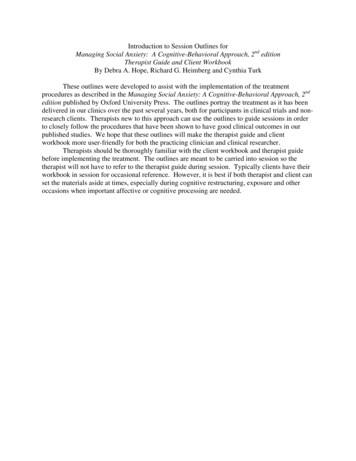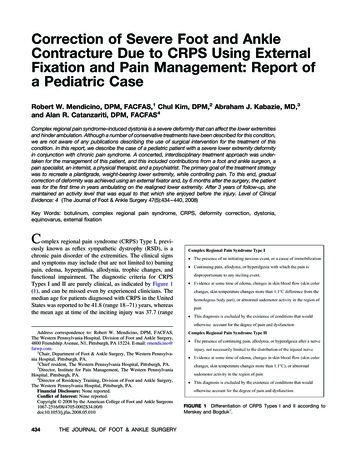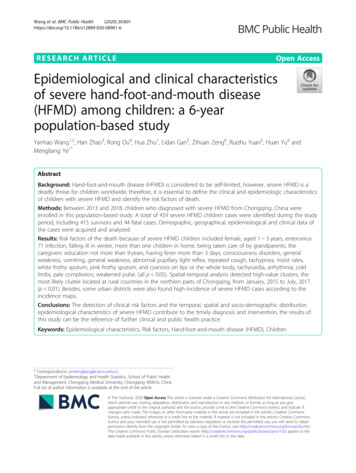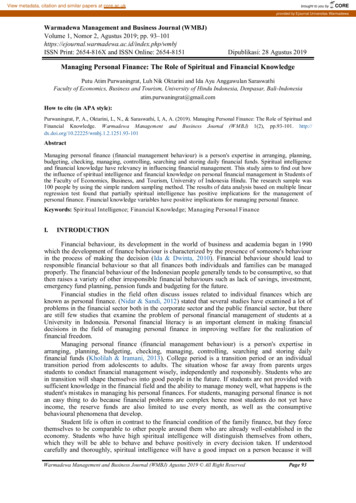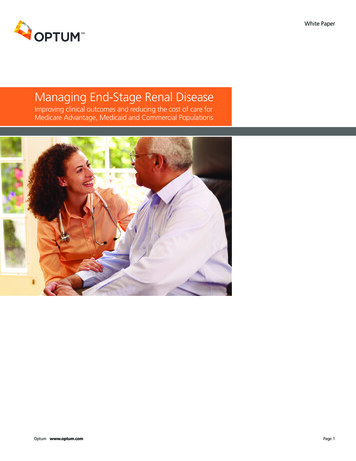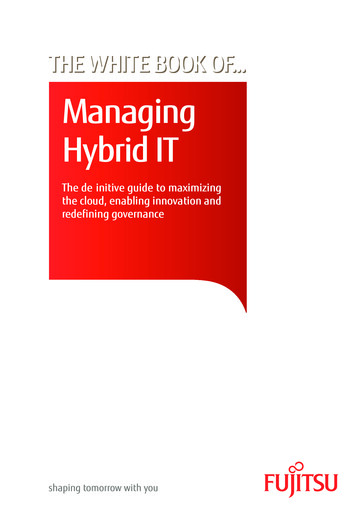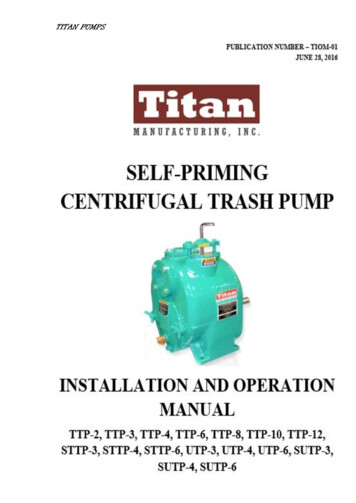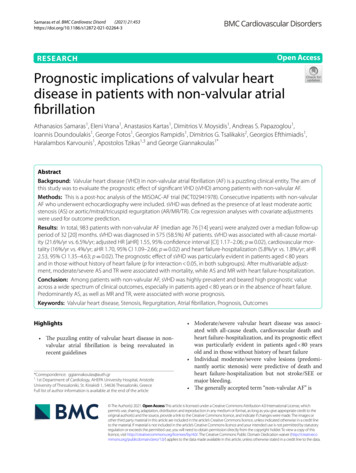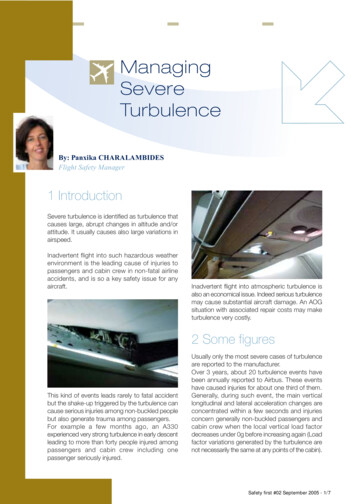
Transcription
ManagingSevereTurbulenceBy: Panxika CHARALAMBIDESFlight Safety Manager1 IntroductionSevere turbulence is identified as turbulence thatcauses large, abrupt changes in altitude and/orattitude. It usually causes also large variations inairspeed.Inadvertent flight into such hazardous weatherenvironment is the leading cause of injuries topassengers and cabin crew in non-fatal airlineaccidents, and is so a key safety issue for anyaircraft.Inadvertent flight into atmospheric turbulence isalso an economical issue. Indeed serious turbulencemay cause substantial aircraft damage. An AOGsituation with associated repair costs may maketurbulence very costly.2 Some figuresThis kind of events leads rarely to fatal accidentbut the shake-up triggered by the turbulence cancause serious injuries among non-buckled peoplebut also generate trauma among passengers.For example a few months ago, an A330experienced very strong turbulence in early descentleading to more than forty people injured amongpassengers and cabin crew including onepassenger seriously injured.Usually only the most severe cases of turbulenceare reported to the manufacturer.Over 3 years, about 20 turbulence events havebeen annually reported to Airbus. These eventshave caused injuries for about one third of them.Generally, during such event, the main verticallongitudinal and lateral acceleration changes areconcentrated within a few seconds and injuriesconcern generally non-buckled passengers andcabin crew when the local vertical load factordecreases under 0g before increasing again (Loadfactor variations generated by the turbulence arenot necessarily the same at any points of the cabin).Safety first #02 September 2005 - 1/7
To give an order of magnitude of a severe turbulencehere are 3 examples:The first concerns an A340 in cruise. Themaximum and minimum vertical load factorexcursions were 2.3g and –0.9g both recordednear the centre of gravity within a few seconds. The second concerns an A320. Within 10 secondsthe successive up and down vertical load factorexcursions were: 1g/1.4g/ 0.2g/3g/ 0.3g/ 1.6g/-0.8g/ 2.6g.During the same period of time the lateral loadfactor varied as follow: 0.2g/ -0.08g / 0.06g/ -0.2g/ 0.2g/ -0.22g/ 0.13g Eventually here below is the profile of the verticalload factor resulting from a turbulence encounteredon an A330.4 Managing severeturbulence Whenever possible, the best solution is to use allthe existing means at the pilots’ disposal to localisethe turbulence as well and as early as possible inorder to have enough time to properly avoid it orat least to secure the cabin when it is unavoidable.But the analysis of several turbulence events hasled to the conclusion that, as further developedhere below, pilot awareness on the appropriateuse of available means could be improved.4.1 Turbulence detectionOptimum use of weather forecastFirstly weather forecast information available beforetaking-off as well as the weather briefing have tobe as complete as possible and, depending onthe weather context, this information has to beupdated in flight as often as necessary. In somesevere turbulence events, analysis has shown thatan appropriate update of weather information inflight would have very likely allowed the detectionand consequently the avoidance of the area ofturbulence.Optimum use of the weather radar3 Maintenance actionsTurbulence can be considered as excessive whenpassengers and crew are moved violently againsttheir seat belts and objects move around the aircraft.In this case, the pilot must make a logbook entryfor maintenance action initiation.Inspection that is recommended after flight inexcessive turbulence (or in excess of VMO/MMO)is described in Aircraft Maintenance Manual (AMM)section 05-51-17.In case of severe turbulence it is also recommendedto inform Airbus.Note that in some remote caseswe have determined that limit loads have beenlocally exceeded. In these cases some additionalinspections (On top of what is recommended inAMM section 05-51-17) may be required.Modern aircraft are equipped with airborne weatherradars. The principle of these radars is to detectprecipitation such as wet turbulence and wet hailbut these radars will not detect wind, ice, fog andClear Air Turbulence (CAT).Despite weather radar efficiency to detect convectiveclouds, in-service events analysis has shown thata large part of turbulence events comes from aircraftincursions into cumulonimbus (CB) that were eithernot localised by the crew or not avoided withsufficient margin.Indeed weather radar is only helpful if: It is properly tuned (tilt, weather mode and rangecontrol on the Navigation Display) to present anoptimum weather radar picture AND the flight crew performs regularly verticalscan AND the flight crew correctly interpretes the screendisplay.Safety first #02 September 2005 - 2/7
For this a good knowledge of the radar systemitself is essential and allows to optimise the use ofthe radar that will be tuned using all availableinformation (pre-flight briefing, reported turbulence,updated weather forecast ).The official investigation launched further to aturbulence event where six cabin crew and threepassengers were seriously injured concluded thefollowing:"It is highly probable that the flight crew were notpresented with the optimum weather radar picturethat would have enable a full appreciation of theintensity and extend of the weather in the vicinityof the aircraft. As the result the deviation .wasnot initiated early enough nor large enough to avoidthe weather"This event is not an isolated case. The analysis ofa large percentage of turbulence events inconvective environment shows a sudden headingchange demand just before encountering theturbulence that has made the radar tuning andpicture interpretation questionable.For example it is important to notice that a tiltsetting in cruise too close from horizon (as presentedin red in the figure here below) will only scan in ahigh range of altitude where humidity is in ice shapeand so not reflective.The aim of this brochure is to provide additionalinformation about the capabilities and the limitationsof the weather radar. It also presents practicalinformation regarding the weather radar tuningand Navigation Display interpretation that can beused to improve the flight crew’s overallunderstanding of the system.Alike all other Flight Operations Briefing Note, the“optimum use of weather radar” Briefing Note canbe downloaded from the Airbus Safety thics/safety lib4.2 Careful turbulence avoidance whendetectedFurthermore as explained in the “optimum use ofweather radar” Briefing Note and in the FCOM section3.04.34 of Fly-by-wire aircraft (Weather radar sectionof the Supplementary techniques dedicated tonavigation), turbulence associated with a cumulonimbusis not limited to inside the cloud.Thus, as current weather radars cannot detect dryturbulence it is essential to take adequate precautionarymeasures: In particular, to minimise the risk of encounteringsevere turbulence, a cumulonimbus should be clearedby a minimum of 5000 feet vertically and 20NMlaterally. Furthermore, if the top of cell is at or above 25000feet, over-flying should be also avoided due to thepossibility of encountering turbulence stronger thanexpected. In the same way flight under a thunderstorm shouldbe avoided due to possible wind shears, microburst,severe turbulence or hail.As illustrated with the in service event examplehere above there is certainly a need to increasepilot knowledge on weather radar.This is why Airbus Flight Operations Departmenthas issued a Briefing Note dedicated to theOptimum Use of the Weather Radar.Safety first #02 September 2005 - 3/7
In this case fasten seat belt signshould be illuminated and cabincrew should closely checkpassenger seatbelts compliance.But to be efficient this measure mustbe used with distinction since a toolong or too frequent use will make itcounterproductive because notstrictly followed.In the same spirit, adviseannouncementrequiringpassengers to keep their seatbeltsfastened at all times when seatedis also an efficient measure toprevent non-predictive turbulenceas CAT.Flight attendantsA part of injuries comes from objects thrown outand coming down on buckled people.Consequently a prime task of the cabin crew is tosecure trolleys and any object that can be harmful.Except if this is specificallyrequested by the flight crew, whenthe seatbelt sign is illuminated, flightattendants usually continue thecabin service.In case of specific announcementof turbulence anticipation by theflight crew, flight attendants willsecure the trolleys and ensure thatall passengers are fastened beforesitting down and buckling upthemselves. Consequently they secure themselvesquite late, which explains that injuries often concernflight attendants.Graduation in the urgency of the flight crew warningproperly perceived by the cabin crew could allowthem to better adapt their actions to the situation.Passengers4.4 Turbulence crossingMost of injuries result from non-buckled passengersor crewmembers thrown out during the turbulence.This could be prevented with seat belts fastened.Although the ideal situation would be to consider“seat belts fastened” as a full-time countermeasure,the minimum recommendation, which is normallyapplied, consists in requiring seat belts fastenedwhen moderate or stronger turbulence isanticipated.Because some turbulence are not detectable bycurrent onboard weather radar or other cannot bedetected early enough to be avoided, aircraftbehaviour when crossing a severe turbulence hasalso to be considered and optimised.Recommendations depend on the aircraft type.4.3 Secure passengers and cabin crewFasten equipmentFor A300/A310/A300-600: Disconnect ATHR/Descent at or below optimum altitude /Safety first #02 September 2005 - 4/7
Consider Autopilot disconnection if Autopilotdoes not perform as desiredDisconnect the ATHR Set the target thrust to follow the speed target(that depends on altitude) given in QRH 13.04. Descent at or below the optimum altitude givenin QRH 17.01. Indeed at the turbulence penetrationtarget speed, this optimum altitude must providesufficient margin to buffet to face severe turbulence. Consider Autopilot disconnection if Autopilotdoes not perform as desired.react to the turbulence by short term side stickinputs corrections and to keep Autopilot engaged. For Fly-by-wire aircraft: Keep Autopilot engaged- Keep ATHR engaged except if thrust changesbecome excessiveRecent severe turbulence events have clearlyillustrated that potential consequences have beenminimised thanks to the appropriate use ofautomation by the crew, mainly in keeping Autopilotengaged instead of possible instinctive reaction,which is to take over manually.As per FCOM recommendation (section 3.04.91)when encountering a severe turbulence the followingprocedure has to be applied: Follow the speed target (that depends on altitude)given in Section 3.04.91. Maintain ATHR engaged (target speed) except ifthrust changes become excessive. In this caseATHR will be disconnected and thrust will be setto give the recommended speed (See thrust tableversus speed target in the same FCOM section). Keep Autopilot engaged. Indeed, detailed studiesregarding aircraft behaviour when crossing suchexternal perturbations has shown that the less theaircraft reacts at short term to the turbulence, thebetter it is. Indeed, the dynamic of such severeturbulence is so, that any additional pitch downreaction to counter the initial up draught willaccentuate in most cases the pitch down effectof the down draught usually subsequent to the updraught. This will accentuate the excursion innegative load factor and so increase the risk andnumber of injuries. To minimise the additional effectof such pitch down order coincident to the downdraught, it is recommended to the crew not toSoftware Flight Control modifications on Flyby-wire aircraftA severe turbulence may lead to excessive highspeed excursion (beyond VMO/MMO) or toexcessive low speed excursion (below ‘alpha prot’,angle of attack threshold of alpha protection lawactivation). This will induce Autopilot disconnectionand activation of the appropriate manual flightcontrol law (The VMO/MMO protection or the angleof attack protection that will command respectivelypitch-up and pitch down movement to reducethese excursions).In order to keep the Autopilot engaged as long aspossible, flight controls software modificationshave been developed on fly-by-wire aircraft. Theymake the Autopilot more robust to disconnectionresulting from a transient VMO/MMO or ‘alphaprot’ exceeding subsequent to a severe turbulence.Autopilot robustness improvement in case oftransient ‘alpha prot’ angle of attack exceedancehas been already implemented on all in-servicefly-by-wire aircraft.Autopilot robustness improvement in case oftransient VMO/MMO exceedance has beenintroduced as shown in various flight controlsoftware.These improvements will be also available at theentry into service of the A380.Software including Autopilot robustnessimprovement in case of transientVMO/MMO exceedanceFor the LR aircraft:Standard FCPC L16/M14/P6 respectively for basicA340/A330-300/A330-200Standard FCPC L17/M16/P7 respectively for EnhancedA340/A330-300/A330-200Standard FCPC W10 for A340-500/-600(under development).For the SA aircraft:Standard ELAC L91 and L83 for A318 and A 321Not yet developed on A320 and A319Safety first #02 September 2005 - 5/7
Managing altitude burst consequent to severeturbulenceSevere turbulence can induce significant altitudeexcursions because of the severe turbulence itselfor as a consequence of the triggering of theVMO/MMO protection or the Angle of Attackprotection. Without the pilot in the loop theseprotections will target respectively speed andincidence decrease rather than maintaining thetrajectory.Indeed, when VMO/MMO protection or Angle ofAttack protection has been activated, the Autopilotis automatically disconnected. In these conditions,it is now to the pilot to apply smooth correctionsto manage the aircraft trajectory (and to avoid toapply sudden corrections fighting the turbulence).Speed will not be closely targeted. Indeed a numberof altitude bursts is the consequence of pilotstargeting a large speed margin after recovery fromVMO/MMO. Keeping aware of the surroundingtraffic, a compromise has to be found since suchtoo large speed margins will be obtained at thedetrimental of the trajectory.5 Areas of improvementBenefiting of the progress of technology, severalareas of improvement are being studied at Airbusin liaison with various partners such as:Weather forecasting improvement that will maketurbulence location more reliable and precise andconsequently will allow optimising the route andreducing turbulence hazards.Enhanced weather radar that will earlier detectturbulence (depending on the aircraft speed, 2 or3 minutes is foreseen).Turbulence now-casting that will broadcast pilot’sreports of encountered turbulence to surroundingaircraft. Information regarding turbulence (intensity,location) will be sent by an automated turbulencereporting system and displayed in other airplanes.This system will be particularly helpful to localiseCAT.Cabin safety improvement that will allow toquicker and better secure people and fastenequipment.Clear Air Turbulence detector that will use opticaltechnology.6 ConclusionFlights into severe turbulence are the leading causeof injuries among passengers and cabin crew andmay induce also substantial aircraft damage.Airbus has received a certain number of reportsregarding severe turbulence events. All these eventshave been thoroughly analysed.In response to these analyses the following can besaid: Use of existing detection means to avoidencountering turbulence or to allow cabinpreparation could be greatly improved. In this context Airbus Flight Operations Departmenthas issued a briefing note dedicated to theOptimum Use of the Weather Radar. When the turbulence is unavoidable, the consequences of turbulence could be minimised inmaking appropriate use of operational proceduresto better handle the turbulence. Airbus has also developed and implementedsoftware flight control modifications on Fly-bywire aircraft in order to improve Autopilotrobustness to severe turbulence. Additional ways to mitigate the turbulence areunder development. We will let you know whenyou get mature solutions.The briefing note dedicated to the optimum use of the weather radar can bedownloaded from the Airbus Safety Library afety libSafety first #02 September 2005 - 6/7
SAFETY FIRSTThe Airbus Safety MagazineFor the enhancement of safe flight throughincreased knowledge and communications.Safety First is published by the Flight Safety Departmentof Airbus. It is a source of specialist safety informationfor the restricted use of flight and ground crew memberswho fly and maintain Airbus aircraft. It is also distributedto other selected organisations.requirements or technical orders. The contents do notsupersede any requirements mandated by the State ofRegistry of the Operator’s aircraft or supersede or amendany Airbus type-specific AFM, AMM, FCOM, MELdocumentation or any other approved documentation.Material for publication is obtained from multiple sourcesand includes selected information from the Airbus FlightSafety Confidential Reporting System, incident andaccident investigation reports, system tests and flighttests. Material is also obtained from sources within theairline industry, studies and reports from governmentagencies and other aviation sources.Articles may be reprinted without permission, except wherecopyright source is indicated, but with acknowledgementto Airbus. Where Airbus is not the author, the contents ofthe article do not necessarily reflect the views of Airbus,neither do they indicate Company policy.All articles in Safety First are presented for informationonly and are not intended to replace ICAO guidelines,standards or recommended practices, operator-mandatedContributions, comment and feedback are welcome. Fortechnical reasons the editors may be required to make editorialchanges to manuscripts, however every effort will be madeto preserve the intended meaning of the original. Enquiriesrelated to this publication should be addressed to:AirbusProduct Safety department (GS)1, rond point Maurice Bellonte31707 Blagnac Cedex - FranceFax: 33(0)5 61 93 44 29safetycommunication@airbus.comSafety First# 02 September 2005Safety First is publishedby Airbus S.A.S1, rond point Maurice Bellonte31707 Blagnac Cedex / FranceEditors:Yannick Malinge,Vice President Flight SafetyChristopher Courtenay,Director of Flight Safety Airbus S.A.S. 2005 – All rights reserved. Confidential and proprietary documents.By taking delivery of this Brochure (hereafter “Brochure”), you accept on behalf of yourcompany to comply with the following guidelines:No other intellectual property rights are granted by the delivery of this Brochure than theright to read it, for the sole purpose of information.Concept Design byHCSGM 20050744Production by Quat’coulThis Brochure and its content shall not be modified and its illustrations and photos shallnot be reproduced without prior written consent of Airbus.Copyright: GSEThis Brochure and the materials it contains shall not, in whole or in part, be sold,rented, or licensed to any third party subject to payment.Photos copyright AirbusPhotos by ExM:Hervé BerengerPhilippe MascletHervé GousséThis Brochure contains sensitive information that is correct at the time of going to press.This information involves a number of factors that could change over time, effecting thetrue public representation. Airbus assumes no obligation to update any information containedin this document or with respect to the information described herein.Printed in FranceAirbus SAS shall assume no liability for any damage in connection with the use of thisBrochure and of the materials it contains, even if Airbus SAS has been advised of thelikelihood of such damages.Safety first #02 September 2005 - 7/7
3 Maintenance actions Turbulence can be considered as excessive when passengers and crew are moved violently against their seat belts and objects move around the aircraft. In this case, the pilot must make a logbook entry for maintenance action initiation. Inspection that is recommended after flight in excessive turbulence (or in excess of VMO/MMO)

